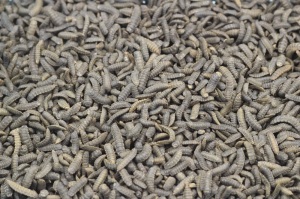
Some things just seem to make sense. Take insect feed for aquaculture. Many fish naturally eat insects; anyone who’s cast a fly rod can attest to that. Insects are easy to raise; anyone who’s ever faced a fruit fly infestation can begrudgingly admit that. And, they’re also high in protein and fat, as well as low in waste. Insects are an economical, environmentally efficient, nutrient rich feed that could reduce the need for wild caught fish feed or other plant-based protein feed additives in aquaculture. This seems like a win all around, right?
So, why aren’t we feeding more insects to farmed fish (or chickens or pigs, for that matter)?
Well, the answer isn’t because the fish won’t eat them nor is it because insect feed produces an inferior aquaculture product. Research overwhelmingly indicates that many farmed fish easily take to an insect-based diet and that diet doesn’t taint the taste or quality of the final product to market.
The answer is, in most cases, because of regulations. Insects are commonly allowed in pet or zoo animal foods without a problem. But, when insects are fed to animals intended for human consumption, they fall into a general livestock category and are governed by the same rules as cows, pigs, and chickens – which were not necessarily intended to apply to the likes of flies and mealworms.
The European Union (E.U.), for example, banned the use of livestock products (insects, included) in livestock feed in the wake of the outbreak of Mad Cow Disease. As a result, insects cannot currently be fed to chickens or pigs. However, an exception to that legislation has been made for farmed fish and, since 2013, insects have been allowed in aquaculture feed. But, because they are still considered livestock, insects must be killed in a certified slaughterhouse in the presence of a welfare officer. What exactly a humane slaughterhouse means for maggots is hard to say.

In the U.S., the use of insect feed is a state by state decision and only a few states, such as Ohio, allow insect-based feed for aquaculture and poultry. But, the U.S. Food and Drug Administration (FDA) doesn’t allow insect feeds to cross state lines, probably limiting the practicality of large-scale insect use in fish farming. The FDA is currently undertaking trials to verify if insect feed is safe for people, animals, and the environment. These tests will assess if insects accumulate environmental toxins or transmit diseases to the animals they feed, and therefore whether farmed fish that are fed insects are safe for human consumption (like that wild caught salmon available at your local grocery store which has surely eaten insects during its lifetime). This federal approval process can be exhaustive but, if shown to be safe, national approval could come as early as September of 2016. The Canadian Food Inspection Agency is also evaluating the use of insects for aquaculture and poultry feed.
Aquaculture is the fastest growing food production sector in the world. With the global human population anticipated to increase from the current 7 billion to 9-10 billion by 2050 and most wild fish capture fisheries at or above maximum sustainable yield, aquaculture production will need to significantly increase if fish supplies are to adequately meet demand by mid-century. Insect-based feeds are a promising new development in aquaculture (as well as other food-production systems). But, they won’t be in common use until they’ve been thoroughly vetted by governments to ensure their food and environmental safety.

Do these regulations distinguish between insects and say freeze dried ones?
From my understanding, the regulations currently apply to all insect-based feeds, including freeze-dried varieties, to be fed to animals for human consumption. But, they don’t apply to pet feeds.
Interesting information.thank you
I am confused as to why we allow wild caught fish and free range chickens in our diet, knowing too well that those animals eat wild insects and/or other wild animals, yet we are so hung up on feeding insects to farm raised animals. If this is all because of the situation from mad cow disease (feeding animal byproduct to herbivores), how is it feasible to apply a blanket ban for animals that are omnivores? Any thoughts on this?
As I recall, Mad Cow disease had nothing to do with insects and a lot to do with feeding ground up dead cows to cows.
This is bureaucratic obstruction, plain and simple.
I propose this experiment. Let Birds eat bugs. Let Fish eat bugs. Let People eat birds and fish. Repeat for a million years. No ill effect so far. End of Experiment.
Reblogged this on save our blue planet and commented:
I wondered about this, too.
Interesting article
Do you have the source for the laws regarding insect feed for poultry and aquaculture?
Thanks for your question, Daniel!
It is our understanding that there is no current legislation in the US for insects as food or feed. The US Food and Drug Administration (FDA) Defect Levels Handbook (http://www.fda.gov/Food/GuidanceRegulation/GuidanceDocumentsRegulatoryInformation/SanitationTransportation/ucm056174.htm#CHPT3) does list allowable levels of accidental insect parts in food, but FDA does not provide guidance on specifically using insects in livestock or aquaculture feed other than stated than insects farmed for food must be specifically bread for human consumption.
For more information, please consider visiting:
Click to access i3253e.pdf
http://www.fda.gov/AnimalVeterinary/Products/AnimalFoodFeeds/ucm050223.htm
http://www.nmfs.noaa.gov/aquaculture/faqs/faq_feeds.html